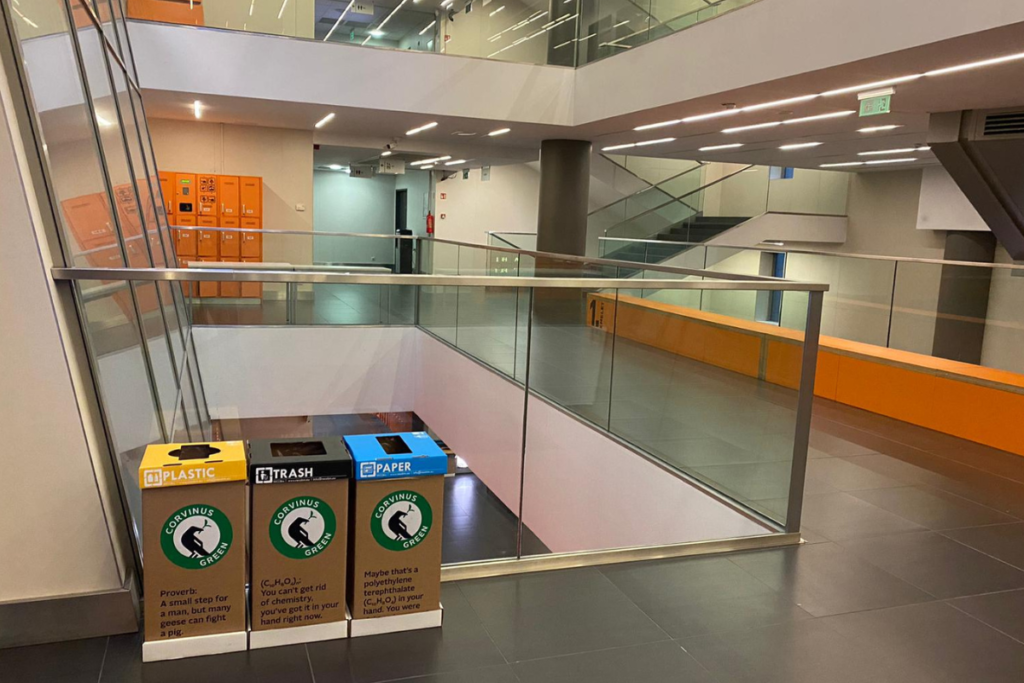Corvinus Green: how could we generate less waste at the University?

Every year, almost 230 tons of waste are removed from the buildings of the Corvinus University, and if we calculate with the municipal waste per capita in the European Union, this corresponds to an average waste generation by approximately 430 EU citizens (this figure was 530 kg/person in 2021). In Hungary, more than 2.5 million tons of waste were removed from the households in 2021 by the public services, according to the data of the Central Statistical Office (this is not necessarily identical with the total waste generation), and together with waste from other organisations, the total amount was 3.1 million tons.
The reduction of the waste load would be important not only from the aspect of the pollution of land and sea ecosystems, but from the aspect of carbon dioxide emission, too. From the extraction of fossil fuels required for the production of polymers, to the transportation and disposal of waste, only in 2021, single-use plastics generated 450 million tons of greenhouse gas that warms up the planet, according to The New York Times.
We are all responsible for the mitigation of waste load, and one of the possible methods is the 5R model, which may help us to start our journey towards a zero-waste way of life.
Think it over whether you really needed the product that generated waste, and refuse to buy products you actually do not need. You can also reduce the waste load, for instance by using less packaging. If you definitely needed a product, you might as well reuse it, or repurpose it in another area. The next step could be the selective collection of waste (recycling), which can give new meaning to objects thrown out.
Selective waste collection and recycling are only the last steps in the model, aimed at the proper treatment of eventually generated waste. This does not mean that we have nothing else to do in the field of selective waste collection: at the Corvinus, for instance, only 12 per cent of the removed waste comes from selective containers, i.e. 88 per cent of the waste generated in the buildings ends up as municipal waste.
As part of the Corvinus Green project, we would like to support this process, therefore we installed more than 320 new selective waste bins in the buildings. Collection boxes made of recycled cardboard are suitable for the selective collection of paper and plastic waste. The collection islands are located at the busiest junctions, for example next to stairs, lecture halls, toilets, so that everyone could have easy access to them.
Yellow waste bins are for the collection of plastic waste. Among other things, they collect PET bottles of soft drinks and mineral water, rinsed household bottles and their removed caps, clean household foils, milk and yoghurt cups, rinsed beverage cartons. The blue containers are exclusively for clean paper waste, for example newspapers, corrugated paper, wrapping paper, flattened cardboard boxes. Documents containing sensitive data may be placed into the bin after proper shredding only. Detailed information on sorting is available on the FKF site.
Waste bins wear short messages, too, to draw attention in a playful way to the importance of generating less waste. On the containers, you can read short slogans like ‘don’t be afraid to part with it, you’ll get it back renewed’, ‘the best selective collection is zero waste’, ‘whatever is produced on the Earth, will stay on the Earth’, or ‘Congratulations! Now you have avoided a trip for two to the Waste Islands!’
The 5R model has been extended with two additional Rs. One of them is ‘Rot’, i.e. composting, and the other is ‘Repair’, i.e. fixing used and broken things, which is a key objective in European Union regulations. These pillars will help us to find the solution that suits best the given situation so that we could avoid the generation of waste, or – if that is not an option – we could treat it properly.
The employees have also been asked to comment on the sustainability of the Corvinus. In the questionnaire related to the Corvinus Green project, respondents shared various ideas, such as reducing the volume of printing, more colourful biodiversity in the campus, selective waste collection, and optimising the efficiency of the water, electricity and air-conditioning technology. We would like to gradually incorporate these ideas into the operation, and the increasing of the number of selective waste bins is also part of it.
The Corvinus University of Budapest is committed to support community sustainability activities and sustainable operation, as we need joint action to achieve significant changes.